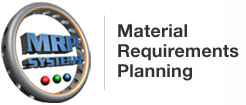General MRP Control
Menus
Moving around the menus is as simple as taking the Option Number, and pressing <enter> or <carriage return>. Pressing <enter> on its own, takes you back to the proceeding menu. Pressing “E” logs you off the system.
There are “shortcuts” to all modules, by pressing the first letter of that module.
P .......... Parts File
N .......... Serial Number Control
R .......... Reservations / Works Orders
I .......... Issues
O .......... Purchase Order
B .......... Bill Of Materials
S .......... Sales Order Processing
G .......... Gross Requirements
C .......... Process Control
W .......... Warehouse Menu
F .......... Financial Ledgers
U .......... Utilities Menu
A .......... Administration Menu
D .......... User Defined Menu
Function Keys
On top of the shortcut keys, Function Keys F1 to F12 can be programmed to jump directly to any given program within the system. There are a default set of options already assigned to the function keys, but these can be tailored on a “user by user” basis if required. The function keys are “unique” to that user-id. Therefore, if a user logs onto someone else’s PC, the function keys will be assigned as per that users requirements, not the person that usually uses the PC.
Function Keys are “one way” control, which means by pressing the key you go to that program and do not return back to the program from where you started. For safety, function keys are disabled inside “destructive” programs. For example, Create Sales Order will have the function keys disabled, so you cannot jump out of it by mistake.
F1 to F10 defaults are as follows
F1 Display Parts
F2 Free Stock Enquiry
F3 Create Purchase Order
F4 Goods Received
F5 Create Sales Order
F6 Sales Order Despatch
F7 Master Sales Enquiry
F8 Parts Explosion
F9 Sales Top 100 List
F10 Special Promotions / Deals
Searching
There are many search facilities within the system to help you locate Part Numbers, Suppliers, Customers, Purchase & Sales Orders, and other codes which may be required for specific modules.
The options are as follows:
Part Number
?xxxx Pressing “?” and up to 6 digits of the part number will show you all parts starting with those
Characters
D Drops to the Full Description field where you can enter up to 2 words. These can be full or
partial words and in no particular order.
S Allows you to enter a Supplier Part Number, assuming they have been maintained on
Buying Cards
C Allows you to enter a Customer Part Number, assuming they have been maintained on the
Customer Parts option
O Allows you to enter an Old Part Number, if this part supersedes an existing one. Old Part Numbers are entered onto the 2nd page of the Stock record.
Supplier
D Drops to the Name field and allows you to enter any part of the Suppliers Name
Customer - Main
?xxxx Pressing “?” and up to 6 digits of the customer number will show you all customer codes
starting with those Characters
D Drops to the Name field and allows you to enter any part of the Customers Name
DA Drops to the Address field and allows you to enter any part of the Customers Address
Customer – Delivery
? Shows you all Delivery Addresses assigned for a Customer
DA Drops to the Address field and allows you to enter any part of a Customers Delivery
Address
PC Allows you to enter Post Code lookup facility
Sales Order Module
When in Update / Delete or Display sales order you may also enter
?S show all out/s Sales Orders
?E show all out/s Sales Enquiries
?G show all out/s General Proforma Orders
O Allows you to enter a Customer Order Reference
When you are in the “specific” sales area of the System, (i.e. Sales Enquires, or Sales Orders, Sales History), then you only need to enter the “?” to show the appropriate items.
Any other fields that require codes (i.e. Salesman, Area, Promotion, Currency, VAT), you can usually press “?” and it will display the current active list available.
Help Screens
When you have selected your method of “searching”, the help screen that appears usually displays 14 items per page. In the top right hand corner is will display the “current” page you are on, and the “maximum” number of pages there are available.
You may enter “N” for Next Page, “P” for previous Page, “E” to terminate the search or the Line Number you wish to view. The hidden options on top of this are “Pxx”, where “xx” is the Page Number you wish to jump to (i.e. P10, go to Page 10). You may also enter an arbitrary Line Number outside of the “valid lines” on the current screen, and the screen will jump to the Page that this line number would appear (i.e. 333 would jump to the page that line 333 would appear, in essence, Page 24)
EDITOR
There is an EDITOR within the MRP when sitting on TEXT fields. This editor is invoked by pressing <ctrl> E and pressing <enter>. Once you perform this, in the top left hand corner you will see EDIT MODE status. This allows you to edit the line of data you are currently sitting on. For example, EVERBALS on Purchase & Sales Orders, is a nightmare if you have to retype the entire line, just to change one character. Valid EDIT commands are
<ctrl> E invoke EDITOR MODE
Left Arrow move left
Right Arrow move right
I insert characters
D delete characters
R replace (overtype)
Y delete (from current cursor position) to end of line
W wipe out entire line and start again
ESC the escape key takes you out of INSERT or REPLACE mode, hence the other EDITOR
keys will operate
<enter> confirm the data input
Other Notes
Please note that this document refers to the global search character as “?”. If your system has been updated to use a different character (such as “H”), then use that reference instead.



